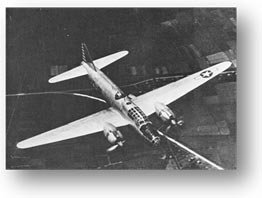The Mitsubishi G4M was a Japanese two-engine long-range bomber of the Second World War. Initially Mitsubishi had planned to equip the machine with four engines, but the Japanese Navy opted for a twin engine version. In 1937, the Navy issued a specification to Mitsubishi for a replacement to the Mitsubishi G3M bomber. The final requirements were for a twin-engine, land-based attack bomber which could fly at a top speed of 398 kmph (247 mph) and at an altitude of 3,000 m (9,845 ft) that could fly a distance of 4,722 km (2,933 miles) without a torpedo or equivalent weight in bombs. While carrying an 800 kg (1,768 lb) torpedo or the same weight in bombs, the Navy wanted the bomber to fly a minimum of 3,700 km (2,300 miles).
To meet the requirements, a Mitsubishi design team led by Kiro Honjo designed the G4M. Its fuel tanks in the wings were not resistant to explosion when punctured during combat. Due to its poorly protected fuel tanks, the G4M also called as “Betty” was sarcastically referred to as the “Flying Zippo”, “flying lighter” and “One-Shot Lighter” by Allied fighter pilots. Its tanks were much lighter in weight than explosion-proof (self-sealing) gas tanks.
The fuselage of G4M was made streamlined but it was a bit plump which allowed space for a bomb bay within the wing centre section and to let a 7 to 9-man crew to move about. One of its variant G4M3 Model 34 was powered by two 1825 hp Mitsubishi MK4T Kasei 25 14-cylinder radial piston engines which had the power to make the aircraft fly at a top speed of 470 kmph and a range of 4335 km. About half the crew consisted of gunners who had given the duty to secure its defensive armament positions. It’s armaments consisted of two 7.7 mm machine-guns mounted in the nose, two 7.7 mm machine-guns in beam positions, one 20 mm Type 99 cannon in a dorsal turret, one 20 mm Type 99 cannon in a tail turret, and either a 800 kg torpedo or up to 1000 kg of bombs. In order to meet the Navy’s demands for great range, designer Honjo again sacrificed crew protection by omitting the airplane’s armor plate.
With worsening of the war situation and heavy losses being suffered by the Japanese, only night operations were made as day time operations had become virtually impossible. 4 major variants for Mitsubishi G4M were built. These were the G4M1 Model 11, G4M2 Model 22, G4M3 model 34 and the G6M1. Also, there were some minor versions, such as the G6M1-L2, as a transport plane. A total of 2,479 machines and in the end of the war only about 160 machines survived.
Specifications
| Type: | Long Range Bomber |
| Allied Codename: | Betty |
| Accommodation: | 7 |
| No. of airplane built: | Approximately 2,446 including all its variants |
| Engine: | Two Mitsubishi MK4T Kasei 25 Radial 1,825 HP |
| Wing Span: | 25.00m (82 ft. 0.25 in.) |
| Length: | 19.50m (63 ft. 11.75 in.) |
| Height: | 6.00m (19 ft. 8.25 in.) |
| Wing Area: | 78.13 m² (841.01 sq ft.) |
| Empty Weight: | 8350kg (18,049 lb.) |
| Max. Take-Off Weight: | 12500kg (27,558 lb.) |
| Max. Speed: | 470 km/h (292 mph) at 5150m (16,895 ft.) |
| Service Ceiling: | 9220m (30,250 ft.) |
| Max. Range: | 4335 km (2,694 miles) |
| Armaments: | Four 20-mm cannon Two 7.7-mm (0.303-in) machine guns and One 800 kg (1,764 lb) Torpedo or 1000 kg (2,205 lb.) of bombs |
